By Professor Tiffany Banks On Tuesday, September 30th , students from my COMM 108: Foundations…
By Professor Michelle Prendergast, English
One of the first memories I have of visiting a museum is my family’s visit to the Smithsonian American History Museum when I was in second grade. My family’s vacation to DC that year was a dazzling experience; my eyes were accustomed to the Rust Belt dreariness of dilapidated buildings that had long ago seen their glory days in my hometown, and as a result, the beautiful, pristine Greco-Roman styled stone buildings along the National Mall mesmerized me. There are many other ways in which traveling to DC expanded my young world, but most significantly visiting the Smithsonian American History and Natural History Museums opened up a new way of seeing and thinking. Even thirty years later, I have clear memories of my face practically pressed against the glass to get as close to Dorothy’s “Ruby Red Slippers” as possible because I could not believe that something so familiar was displayed in this enormous building.
As we have discussed throughout our two semesters in the Smithsonian Faculty Fellowship, my young experience demonstrates the powerful effect that objects have on us. The artifacts I viewed as a child sparked many instances of wonder and curiosity, and my experience with seeing these objects in person is lodged in my memory. It is clear from reflecting on my pre-educator experience at museums that museums offer us a powerful, organic way to engage with critical-thinking about our world that has lasting resonance. As a result, I wanted to share this experience with our students.
During the Fall 2019 semester, students in my English 102 and my Renaissance Scholars Seminar (Culture and Identity in American Literature) visited the Smithsonian American History Museum’s “Many Voices, One Nation” Exhibit. When the Faculty Fellowship visited this museum in the spring, I was moved by the questions that influenced the theme of the Exhibit: “Who is free? Who is equal? Who is included? How did we become US?” This naturally paired quite well with my Renaissance Scholars Seminar topic. Further, I used these questions as a loose basis for the work that we did in my English 102 class, analyzing American identity while meeting the English 102 course outcomes surrounding argumentation, analysis, information literacy, etc. Thus, course readings and essay topics were tailored around this concept.
Prior to visiting the museum, I was curious about the students’ assumptions about what they would see in the museum and I informally asked them to jot down some ideas of what they expected, which I then wrote on the board:
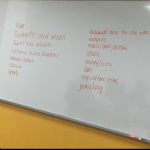
This allowed us to prepare for what to expect, and I was delighted to find that after the visit, they were often quite surprised by what they saw.
While at the museum, students in both courses had to complete an assignment at the museum in which they were asked to find artifacts that they connect to issues of American identity, the American dream, and their own identity as listed here:
- choose one artifact that represents you or that you identify in some way. Take a photo of this artifact. Look at it again and take some notes on what it is (look at the description!) and why you are drawn to it;
- choose one artifact that seems like an idealized representation of the American dream in your opinion. Take a photo of this artifact. Look at it again and take notes on what it is (look at the description!) and what aspect of the American dream that you think it relates to
- choose an artifact that you connect thematically to one of the readings we have read this semester. Take a photo of this artifact. Look at it again and take some notes on the connections you can make between this artifact and the reading you have chosen;
- and The “Many Voices, One Nation” Exhibit poses the questions: “How did we become us? Who is free? Who is equal? Who is included?” Pick one case in which you see several artifacts grouped together. Take a photo of this case. Look at it again and now take notes considering these questions: why do you think the curator grouped these artifacts together? What argument is this collection of artifacts making about how we became us, who is free, who is equal, and/or who is included?
Students’ responses to these questions were at times astonishing. One student who is from Africa noticed the plantation tools used by slaves: “The objects I chose are about ‘Rice Processing.’ The fanner basket is an artifact that I can identify with. When I was little and living in Nairobi, Kenya my mother would use the fanner basket to winnow the husks and chuffs away just like the lady in the image. So, seeing it was very sentimental for me as I have not seen a woman performing such an act in a long time.”
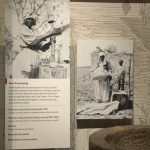
Another student noticed the contrast in the exhibit case that focused on the border between the freshly-pressed border patrol uniform and the poor condition of the objects left by migrants in the Arizona desert; this case had a profound impact on this student and her mother as both her brought to tears when I shared that the curators had informed us that no one knows about the fates of the owners of these objects.
After the museum visit, students were asked to reflect on their experience at the museum and use it as inspiration for further inquiry in one of their argument essays. The essay assignment requires students to use one of the artifacts in the exhibit in developing an original argument about an issue with American identity. Students have gone down a wide-range of paths to answer the prompt; I have read essays ranging from American identity and music to whether education provides access to the American dream. It has been a pleasure to read student writing that formed from their interest being sparked by an object in a museum. In fact, one student reflected that she could not believe that an old yearbook from a segregated high school was featured in the education section, which made her wonder what objects we treat as commonplace (and almost insignificant) will be viewed by someone 100 years from now.
Overall, I believe the Smithsonian visit was a positive addition to the curriculum as it provided students the opportunity to develop more creative and inspired lines of inquiry in their thinking and writing. It seems that many of the artifacts have left a lasting impression on them as evidenced by their writing and reflection. One of the most gratifying aspects of the experience was watching my students engage closely with the artifacts in the exhibit, particularly in contrast to the unfocused and loose wandering that other museum-goers exhibited around them. This level of engagement is reflected in one of my student’s responses to the visit in which she wrote: “the learning experience outside of the classroom was valuable in terms of having an audio and visual experience in the subject.” Finally, one student summed up the value of the partnership between the Smithsonian Museums and Montgomery College when he stated: “I have never been to a Smithsonian Museum before, so it was really nice to see and learn new things. After that, I started going to more museums around the area and I’m planning to go to more.”

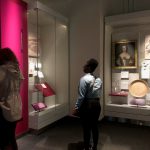
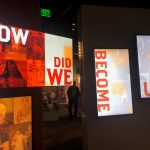
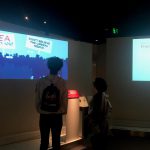






This Post Has 0 Comments